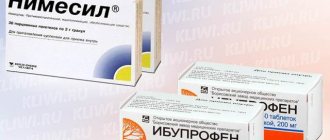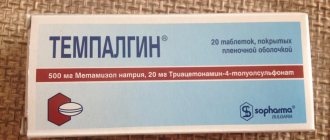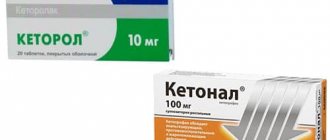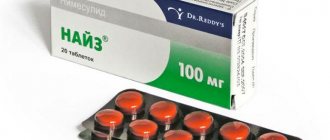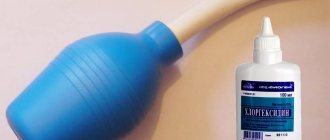Ibuprofen is rightfully considered the most effective and common remedy for treating the symptoms of colds and acute respiratory viral infections. Some patients successfully relieve fever with its help and consider it an antipyretic, while others relieve serious pain of a chronic nature, for example, in the spine. The fact is that Ibuprofen has three properties at the same time: anti-inflammatory, analgesic and antipyretic.
Ibuprofen
Indications for use
Ibuprofen belongs to the group of non-steroidal anti-inflammatory drugs (NSAIDs) - derivatives of phenylpropionic acid. In the instructions for tablets and capsules for adults, we see primarily prescriptions related to the symptomatic treatment of diseases of the joints or spine (rheumatoid arthritis, osteoarthritis, bursitis, sciatica), the fight against pain from injuries, myalgia and neuritis. In children's forms, we find the following indications: sore throat, pain with otitis media, teething, reduction of fever during ARVI or influenza, relief of symptoms of fever during childhood infections and post-vaccination reactions.
Of course, the indications are not limited to those mentioned above. We list here the most common types of pathologies where Ibuprofen does an excellent job eliminating inflammation and pain:
- Pathologies of the musculoskeletal system, pain relief: ankylosing spondylitis, radiculitis, spinal osteochondrosis, exacerbation of gout, polyarthrosis, psoriatic arthritis, tendinitis, inflammation of soft tissues in injuries, back pain, joint pain, trauma, sprains, dislocations, myalgia of various types .
- Diseases of the peripheral nervous system: neuralgia and neuritis.
- Gynecology: primary dysmenorrhea, secondary dysmenorrhea, pain during painful menstruation, with adnexitis.
- Relief of various types of pain: toothache, headache, migraine, sore throat, ear pain with otitis media, muscle pain.
- Use as an antipyretic for fever, flu, ARVI and colds. Increased temperature in infectious and inflammatory diseases.
- Relief after vaccination, including against coronavirus.
Ibuprofen in the practice of a general practitioner: possibilities for relieving pain syndromes
Pain syndromes of various origins are often encountered in the daily practice of a general practitioner, which determines the growing need for effective painkillers. According to the independent research center DSM Group, an analysis of the pharmaceutical market in 2012 showed that painkillers were one of the most popular groups of pharmaceuticals [1]. Analgesics are the most widely demanded category of drugs in the pharmaceutical market [2].
The feeling of pain is familiar to every person. There are probably no people who would not experience a feeling of pain during their lives. The variety of causes of pain determines the high frequency of patients visiting a doctor for this reason. It should be noted that the prevalence of pain syndromes in recent years, despite the development of pharmacy, has not decreased at all [3], on the contrary, there is even a tendency towards its increase, especially for chronic pain [4].
Verification of the cause of pain is one of the keys to its successful treatment. Among pain syndromes, the largest percentage is headaches, the prevalence of which reaches 90% in the population. Among them, tension headaches (up to 60%) and migraines (up to 23%) undoubtedly dominate. A global health survey conducted in 54 countries with 27,000 respondents found that headaches were the most common reason for seeking medical care and taking medications (Figure 1). The prevalence of primary headache in Russia (2725 respondents from 35 cities) reaches 62.9% with some predominance in the urban population, and more than 10% have headaches for more than 15 days a month. 68.1% of respondents indicated self-use of over-the-counter medications [5]. Headaches are the most common health complaint among drug users around the world.
The top ten complaints, along with headaches, also include back pain, sore throat and other types of pain. About 20% of the adult population suffers from recurrent back pain lasting more than three days, of which 20% have pain that lasts more than a month and is chronic. An equally acute problem is muscle pain, which generally occurs in 30–85% of the population. In this case, myalgia can accompany vertebrogenic back pain (in 60% of patients), but can also be primary [6].
The increase in the prevalence and incidence of pain syndromes is associated with both lifestyle changes and the general aging of the population (Fig. 2).
The main trend in patient preferences is the possibility of self-medication, i.e., independent choice of anesthetic. Therefore, as data from epidemiological studies show, most patients with the most common forms of pain syndromes remain outside the attention of specialists. Thus, only about 10% of patients with back pain seek help from specialists. A similar situation occurs with headaches. Thus, among patients with one of the most common forms of cephalgia - migraine - only 1/6 of them turn to specialists, the rest of the patients are outside their field of vision, preferring to be treated independently [6].
Economic burden of pain syndromes
The increasing prevalence of pain syndromes in the population is a significant burden for workers, employers and society, leading to loss of profits and additional costs and payments [8]. A paradox in the pharmacoeconomics of pain is that cost is a potential barrier to optimal pain management, with even suboptimal pain management showing an increase in overall healthcare costs [9].
Thus, in the USA alone, annual costs aimed at pain relief, as well as legal costs and compensation associated with pain syndrome, are estimated at almost 100 billion US dollars [10]. And, for example, in Sweden, the average annual cost of treating diseases associated with chronic pain syndrome (n = 840,000) is 6,400 euros per patient. The majority of costs (59%) are indirect costs (sick leave payments and early retirement), while the cost of analgesics is only about 1%. Overall, the socioeconomic burden of diseases associated with chronic pain syndrome in Sweden alone reaches 32 billion euros per year [11].
Nonsteroidal anti-inflammatory drugs (NSAIDs)
Practical experience shows that NSAIDs are most often used to relieve subjective pain. The presence of universal mechanisms of pain makes it possible to use drugs from this group in various clinical situations. In Europe, NSAIDs are prescribed by 82% of general practitioners and 84% of rheumatologists in polyclinics; in hospitals they are used in 20% of patients [12].
Thanks to the studied analgesic, anti-inflammatory, and antipyretic mechanisms of action, various representatives of NSAIDs have found wide practical use.
NSAIDs are able to relieve pain of various localizations - in the musculoskeletal system, headaches, dental pain, menstrual pain. In addition, all NSAIDs have antipyretic and anti-inflammatory properties. The variety of therapeutic effects of NSAIDs, as well as the high prevalence of clinical situations in which they are effective, make drugs in this group the most frequently prescribed to patients. The need for NSAIDs is especially increasing in older people, who often have concomitant diseases.
The main effects of NSAIDs are associated with the mechanism of suppression of the activity of cyclooxygenase (COX), an enzyme that regulates the conversion of arachidonic acid into prostaglandins, prostacyclin and thromboxane. Differences in the severity of anti-inflammatory, analgesic effects and toxic effects of drugs of this class are associated with their different ability to influence two isoforms of COX - COX-1 and COX-2. The analgesic and anti-inflammatory effects are mainly associated with the inhibition of COX-2, and the development of side effects is associated with the suppression of COX-1. Therefore, the choice of a specific representative is determined by its ability to predominantly influence COX-2.
Analgesic efficacy profile of ibuprofen
One of the most well-known representatives of the NSAID class is ibuprofen, which has been successfully used in clinical practice for more than 30 years and for more than 10 years in over-the-counter form (Nurofen). The high clinical effectiveness of this drug is confirmed by the high demand for it among consumers. Thus, only in the last six months, in terms of share of sales value in Russia, the drug Nurofen has moved from 8th to 3rd place, while occupying a leading position in Moscow [13].
The analgesic effectiveness of ibuprofen has been convincingly proven in various models of pain: toothache [14–16], headache [17–23], sore throat [14], musculoskeletal pain [14–16], etc.
Toothache is well recognized and sensitive enough to evaluate the analgesic effect of drugs. Ibuprofen at a dosage of 200–400 mg is the “gold standard” for the treatment of moderate pain in postoperative dental pain [14]. A meta-analysis demonstrated that ibuprofen was more effective than placebo across 72 studies. Ibuprofen significantly reduced pain in all patients by at least 50%, for an average of 4.7 hours. Repeated analgesia was required in only 48% of patients taking ibuprofen at a dose of 200 mg and in 42% of patients taking ibuprofen at a dose of 400 mg [15]. Another meta-analysis, based on 33 studies, found an advantage of ibuprofen (400 mg) in relieving pain after tooth extraction compared to paracetamol (1000 mg), as well as a combination of paracetamol (600-650 mg) and codeine (60 mg) [ 16].
For headaches, ibuprofen as a first-line drug is included in the list of analgesics recommended by WHO, as well as the European Federation of Neurological Societies (EFNS) for the treatment of mild to moderate migraine attacks (class A) [17, 18]. The effectiveness of ibuprofen in the treatment of cephalgia has been proven in many placebo-controlled clinical trials, as well as several meta-analyses, including in children and adolescents [19–23].
For sore throat due to tonsillopharyngitis, a double-blind, randomized, multicenter study compared the analgesic efficacy of ibuprofen (400 mg) or paracetamol (1000 mg). The severity of pain when swallowing, difficulty swallowing, and changes in pain intensity were assessed every 6 hours after taking the first dose of drugs. Ibuprofen, compared with paracetamol, was significantly more effective in influencing the severity of pain and difficulty swallowing, while the effect of ibuprofen began significantly earlier than that of paracetamol. Treatment tolerability was comparable in both groups, and no serious side effects were observed during the study. Thus, the study showed that ibuprofen is a more effective alternative to paracetamol in the treatment of sore throat [24].
Ibuprofen, having high efficiency and low toxicity, is widely used in the long-term treatment of various inflammatory and degenerative diseases of the musculoskeletal system.
The effectiveness of ibuprofen and its benefits have been repeatedly demonstrated in large-scale studies. An illustrative example is the multicenter randomized IPSO (Ibuprofen, Paracetamol Study in Osteoarthritis) study conducted in 2004 involving 222 patients suffering from osteoarthritis (OA) of the hip (30% of patients) or knee (70%) joint. For two weeks, the WOMAC (Western Ontario and McMaster Universities osteoarthritis index) scale assessed the effect of ibuprofen (400–1200 mg/day) and paracetamol (1000–3000 mg/day) on the severity of pain and joint syndromes. The results of the study showed a greater reduction in pain in the first 6 hours after taking the drug and a more pronounced further reduction within 14 days in the ibuprofen group compared to paracetamol. The authors concluded that ibuprofen with a single (400 mg) or multiple (up to 1200 mg) dose has a better efficacy/safety ratio than paracetamol [25]. The greater effectiveness of NSAIDs, including ibuprofen, compared with paracetamol in the treatment of OA was also demonstrated in a Cochrane review [26].
According to current recommendations, the use of NSAIDs as symptomatic treatment is recommended for all patients with rheumatoid arthritis (RA). Patients with OA are recommended to take NSAIDs only during periods of increased pain and in lower dosages than for inflammatory arthritis [27, 28].
Ibuprofen can be used both in monotherapy and as part of combination therapy in combination with other drugs. Thus, adding the centrally acting muscle relaxant tizanidine to ibuprofen can not only increase the effectiveness of therapy, but also reduce the incidence of adverse events from the use of NSAIDs. Tizanidine has a protective effect on the gastric mucosa from the effects of NSAIDs [29]. This effect was convincingly demonstrated in the work of Berry H. et al., which studied the addition of tizanidine 4 mg to ibuprofen 400 mg three times daily in patients with acute low back pain. The overall effectiveness of treatment in both groups was almost the same, but the safety of treatment was higher with the combined use of ibuprofen and tizanidine. Patients receiving ibuprofen/tizanidine combination therapy reported significantly less gastrointestinal (GIT) side effects compared to the placebo/ibuprofen group (p < 0.002) [30].
Topical forms of ibuprofen
The high demand for ibuprofen drugs is also due to the variety of its dosage forms. In patients with acute or chronic muscular-articular pain, especially with local damage to the musculoskeletal system and traumatic lesions of soft tissues, local use of NSAIDs in the form of gels and ointments is possible, which reduces the systemic effect and, consequently, adverse reactions.
The effectiveness of this dosage form is not inferior to the tablet form. A number of studies have shown that ibuprofen, regardless of the dosage form, is a highly effective NSAID with a good safety profile.
The widespread use of topical forms of ibuprofen is due to the fact that in patients taking oral forms of NSAIDs for a long time, erosive and ulcerative lesions of the gastrointestinal mucosa, including perforation and bleeding, can develop in 22–68% of cases. Moreover, up to 30% of additional costs in the treatment of arthritis can be attributed to the treatment of gastrointestinal side effects caused by taking oral NSAIDs [31, 32]. Given that topical NSAIDs are as effective as oral NSAIDs, their more favorable tolerability profile makes them preferable in certain clinical situations, such as knee pain. Thus, administration of oral and topical forms of ibuprofen has an equivalent effect on knee pain over the course of a year. Due to a more favorable tolerability profile, topical forms of NSAIDs can be prescribed as an alternative to oral forms [33]. Based on the results of a Cochrane review of 47 studies, the authors concluded that when using topical forms of NSAIDs, there is a good effect compared to enteral use and a significantly lower number of complications [34].
The same effectiveness of using a topical form of ibuprofen (5% gel) and oral ibuprofen 400 mg (1200 mg per day) has also been proven for acute soft tissue injury for at least 7 days. In both groups, complete improvement was observed between days 3 and 6 of therapy. It should be noted that the treatment was well tolerated in both groups (the identified cases of adverse events were not related to the treatment) [35].
While topical ibuprofen costs slightly more than oral ibuprofen, overall treatment costs are reduced by reducing the incidence of side effects, as shown in the TOIB study (Topical or oral ibuprofen for chronic knee pain in older people) [36]. .
Safety profile of ibuprofen therapy
The main concern for patients with chronic pain is the safety of the drug used over long-term use. It's no secret that the main serious side effect of all NSAIDs is gastrointestinal bleeding (GI bleeding). Many studies indicate that low dose ibuprofen use (up to 1200 mg/day) causes only minimal damage to the gastrointestinal mucosa, even with long-term use. Ibuprofen, as a drug with well-studied pharmacological effects, is considered the “gold standard” for safety of use, which is especially important in the treatment of patients with chronic pain syndromes. Ibuprofen in low doses (800–1200 mg per day) is approved for over-the-counter use in many countries and has a good safety profile comparable to paracetamol.
Increasing the recommended doses (up to 1800–2400 mg per day) is used in the long-term treatment of rheumatic and some other diseases of the musculoskeletal system. Based on a meta-analysis of observational epidemiological studies from 2000–2008. The influence of various NSAIDs on the risk of bleeding from the upper gastrointestinal tract has been established. As initially expected, the lowest incidence of GI bleeding was observed in the coxibs group (hazard ratio (RR) 1.88; 95% confidence interval (CI) 0.96–3.71), among non-selective NSAIDs, the best results were obtained with ibuprofen ( RR 2.69; 95% CI 2.17–3.33), the greatest risk was observed with ketorolac (RR 14.54; 95% CI 5.87–36.04) and piroxicam (RR 9.94; 95% CI 5.99–16.50). The authors concluded that the frequency of bleeding depends on several factors: the selectivity of the drug with respect to COX, the dosage and duration of use, as well as the half-life or use of a prolonged form of the drug [37]. Similar results were demonstrated in a number of earlier meta-analyses, according to which ibuprofen was characterized by the lowest risk of GI bleeding compared with diclofenac, naproxen, indomethacin, piroxicam and ketoprofen [37–40].
The dose-dependent effect of ibuprofen on the occurrence of serious gastrointestinal complications has been confirmed in a number of other studies. The risk of serious gastrointestinal adverse events with NSAIDs is relatively low, occurring in 1% of patients per year, primarily when used in high doses for long-term treatment of chronic conditions. The incidence of side effects when using ibuprofen in recommended doses in children and adults is comparable to that of paracetamol. Of all NSAIDs, ibuprofen appears to have one of the best gastrointestinal safety profiles [41, 42].
We can clearly conclude that ibuprofen has the best safety profile in relation to the gastrointestinal tract among non-selective NSAIDs, as well as a relatively low risk of developing cardiovascular complications with long-term use.
In accordance with existing recommendations, no advantages in the effectiveness of various NSAIDs, including selective ones, have been reliably identified in the treatment of rheumatic diseases, therefore the choice of drug should be made based on its safety profile and the individual characteristics of the patient. Coxibs are contraindicated in patients at high risk of cardiovascular complications. To reduce the risk of gastrointestinal complications, it is recommended to use misoprostol or proton pump blockers in conjunction with non-selective NSAIDs.
Currently, the first large randomized trial (n = 20,000 patients) is being conducted to establish the safety profile of celecoxib, ibuprofen and naproxen in patients suffering from OA or RA at high risk of developing cardiovascular complications [43]. This study will provide clearer recommendations regarding administration in these patients.
Conclusion
Thus, clinical experience with the use of ibuprofen for the most common forms of pain syndromes demonstrates its effectiveness not only as a means for relieving painful episodes, but also for the course treatment of chronic pain. An additional advantage of this drug is its existence in several dosage forms.
The use of ibuprofen (Nurofen) meets modern standards of pain therapy. Ease of use, variety of dosage forms of the drug and its availability determine high patient compliance with the prescribed therapy, which is the key to successful treatment.
More than 50 years of successful use of ibuprofen in widespread clinical practice in more than 80 countries as an over-the-counter drug serves as a clear example of its high profile of effectiveness and safety [44].
Literature
- Pharmaceutical market of Russia. May 2012 DSM Group. Available at: https://www.dsm.ru/content/file/cpravka_may_2012.pdf.
- Global Healthcare Calls for Target Marketing. Available on: https://blog.nielsen.com/nielsenwire/consumer/global-healthcare-calls-for-target-marketing/.
- Friessem CH, Willweber-Strumpf A., Zenz MW Chronic pain in primary care. German figures from 1991 and 2006 // BMC Public Health. 2009; 9:299.
- Breivik H., Collett B., Ventafridda V., Cohen R., Gallacher D. Survey of chronic pain in Europe: prevalence, impact on daily life, and treatment // Eur J Pain. 2006; 10: 287–333.
- Ayzenberg I., Katsarava Z., Sborowski A. et al. The prevalence of primary headache disorders in Russia: a countrywide survey // Cephalalgia. 2012; 32 (5): 373–381.
- Tabeeva G.R. Ibuprofen in the treatment of neurogenic pain syndromes // Consilium Medicum. 2006; 8 (2): 28–32.
- Blyth FM, March LM, Brnabic AJ, Jorm LR, Williamson M., Cousins MJ // Pain. 2001; 89 (2–3): 127–134.
- Patel AS, Farquharson R., Carroll D. The Impact and Burden of Chronic Pain in the Workplace: A Qualitative Systematic Review // Pain Pract. 2012.
- Chandler S., Payne R. Economics of unrelieved cancer pain // Am J HospPalliat Care. 1998; 15 (4): 223–226.
- National institute of health. The NIH Guide: new direction in pain research I. Washington (DC): US Government Printing Office; 1998.
- Gustavsson A., Bjorkman J., Ljungcrantz C. Socio-economic burden of patients with a diagnosis related to chronic pain - register data of 840,000 Swedish patients // Eur J Pain 2012; 16(2):289–299.
- Topchiy N.V., Toporkov A.S. Optimization of the use of non-steroidal anti-inflammatory drugs in general medical practice // RMJ. 2011; 19 (2): 27–32.
- Pharmaceutical market of Russia. May 2012 DSM Group. Available at: https://www.dsm.ru/content/file/cpravka_may_2012.pdf.
- Derry C., Derry S., Moore RA, McQuay HJ Single dose oral ibuprofen for acute postoperative pain in adults // Cochrane Database Syst Rev. 2009, Jul 8; (3): CD001548. Review. PubMed PMID: 19588326.
- Hersh EV, Kane WT, O'Neil MG, Kenna GA, Katz NP, Golubic S., Moore PA Prescribing recommendations for the treatment of acute pain in dentistry // Compend Contin Educ Dent. 2011, Apr; 32 (3): 22, 24–30; quiz 31–2. PubMed PMID: 21560740.
- Ahmad N., Grad HA, Haas DA, Aronson KJ, Jokovic A., Locker D. The efficacy of nonopioid analgesics for postoperative dental pain: a meta-analysis // Anesth Prog. 1997, Fall; 44 (4): 119–26. PubMed PMID: 9481955; PubMed Central PMCID: PMC2148941.
- Aids for management of common headache disorders in primary care 2007 www.who.int/entity/mental_health/neurology/who_ehf_aids_headache.pdf.
- Evers S., Afra J., Frese A., Goadsby PJ, Linde M., May A., Sandor PS European Federation of Neurological Societies. EFNS guideline on the drug treatment of migraine — revised report of an EFNS task force // Eur J Neurol. 2009, Sep; 16(9):968–981. PubMed PMID: 19708964.
- Rabbie R., Derry S., Moore RA, McQuay HJ Ibuprofen with or without an antiemetic for acute migraine headaches in adults // Cochrane Database Syst Rev. 2010, Oct 6; (10): CD008039. Review. PubMed PMID: 20927770.
- Verhagen AP et al. Treatment of tension type headache: paracetamol and NSAIDs work: a systematic review // Ned Tijdschr Geneeskd. 2010; 154:A1924. Review. Dutch. PubMed PMID: 20699021.
- Suthisisang C., Poolsup N., Kittikulsuth W., Pudchakan P., Wiwatpanich P. Efficacy of low-dose ibuprofen in acute migraine treatment: systematic review and meta-analysis // Ann Pharmacother. 2007, Nov; 41 (11): 1782–91. Epub 2007 Sep 18. Review. PubMed PMID: 17878396.
- Silver S., Gano D., Gerretsen P. Acute treatment of pediatric migraine: a meta-analysis of efficacy // J Paediatr Child Health. 2008, Jan; 44 (1–2): 3–9. Epub 2007, Sep 14. Review. PubMed PMID: 17854415.
- Damen L. et al. Symptomatic treatment of migraine in children: a systematic review of medication trials // Pediatrics. 2005, Aug; 116(2):e295–302. Review. PubMed PMID: 16061583.
- Boureau F., Pelen F., Verriere F. et al. Evaluation of lbuprofenvsParacetamol analgesic activity using a sore throat pain model // Clin Drug Invest. 1999; 17 (1): 1–8.
- Boureau F., Schneid H., Zeghari N., Wall R., Bourgeois P. The IPSO study: ibuprofen, paracetamol study in osteoarthritis. A randomized comparative clinical study comparing the efficacy and safety of ibuprofen and paracetamol analgesic treatment of osteoarthritis of the knee or hip // Ann Rheum Dis. 2004 Sep; 63 (9): 1028–34. PubMed PMID: 15308513; PubMed Central PMCID: PMC1755112.
- Towheed TE, Maxwell L, Judd MG, Catton M, Hochberg MC, Wells G. Acetaminophen for osteoarthritis. Cochrane Database Syst Rev. 2006, Jan 25; (1): CD004257. Review. PubMed PMID: 16437479.
- Rheumatology. Clinical recommendations / Ed. E. L. Nasonova. M.: GEOTAR-Media, 2008. 288 p.
- Zhang W. et al. EULAR evidence based recommendations for the management of hand osteoarthritis: report of a Task Force of the EULAR Standing Committee for International Clinical Studies Including Therapeutics (ESCISIT) // Ann Rheum Dis. 2007, Mar; 66(3):377–388. Epub 2006 Oct 17. PubMed PMID: 17046965; PubMed Central PMCID: PMC1856004
- Watanabe K., Watanabe H., Maeda Hagiwara M. et at. Influence of a muscle relaxant, tizanidine, on gastric acid secretion and ulcers in the rat // Folia Pharmacol Jpn. 1983; 82:237–245.
- Berry H., Hutchinson DR Tizanidine and ibuprofen in acute low-back pain: results of a double-blind multicentre study in general practice // J Int Med Res. 1988; 16 (2): 83–91.
- Aabakken L. NSAID-associated gastrointestinal damage: methodological considerations and a review of the experience with enteric coated naproxen // Eur J Rheumatol Inflamm. 1992; 12 (2): 9–20.
- Russell RI Non-steroidal anti-inflammatory drugs and gastrointestinal damage-problems and solutions // Postgrad Med J. 2001; 77 (904): 82–88.
- Underwood M., Ashby D., Cross P. et al. Advice to use topical or oral ibuprofen for chronic knee pain in older people: randomized controlled trial and patient preference study // BMJ. 2008; 336 (7636): 138–142.
- Tiso RL, Tong-Ngork S., Fredlund KL Oral versus topical Ibuprofen for chronic knee pain: a prospective randomized pilot study // PainPhysician. 2010; 13 (5): 457–467.
- Whitefield M., O'Kane CJ, Anderson S. Comparative efficacy of a proprietary topical ibuprofen gel and oral ibuprofen in acute soft tissue injuries: a randomized, double-blind study // J Clin Pharm Ther. 2002; 27 (6): 409–417.
- Castelnuovo E. et al. TOIB study team. Cost-effectiveness of advising the use of topical or oral ibuprofen for knee pain; the TOIB study Rheumatology (Oxford) 2008; 47(7):1077–1081.
- Masso Gonzalez EL et al. Variability among nonsteroidal antiinflammatory drugs in risk of upper gastrointestinal bleeding // Arthritis Rheum. 2010 Jun; 62(6):1592–1601. PubMed PMID: 20178131.
- Lewis SC et al. Dose-response relationships between individual nonaspirin nonsteroidal anti-inflammatory drugs (NANSAIDs) and serious upper gastrointestinal bleeding: a meta-analysis based on individual patient data // Br J Clin Pharmacol. 2002, Sep; 54(3):320–326. PubMed PMID: 12236853; PubMed Central PMCID: PMC1874428.
- Henry D. et al. Variability in risk of gastrointestinal complications with individual non-steroidal anti-inflammatory drugs: results of a collaborative meta-analysis // BMJ. 1996, Jun 22; 312(7046):1563–1566. PubMed PMID: 8664664; PubMed Central PMCID: PMC2351326.
- Richie F. et al. Time dependent risk of gastrointestinal complications induced by non-steroidal anti-inflammatory drug use: a consensus statement using a meta-analytic approach // Ann Rheum Dis. 2004, July; 63(7):759–766. Review. PubMed PMID: 15194568; PubMed Central PMCID: PMC1755051.
- Doyle G., Furey S., Berlin R. Gastrointestinal safety and tolerance of ibuprofen at maximum over-the-counter dose // Aliment Pharmacol Ther. 1999; 13(7):897–906.
- Bjarnason I. Ibuprofen and gastrointestinal safety: a dose-duration-dependent phenomenon // JR Soc Med. 2007; 100 Suppl 48:11–14.
- Becker MC et al. PRECISION Investigators. Rationale, design, and governance of Prospective Randomized Evaluation of Celecoxib Integrated Safety versus Ibuprofen Or Naproxen (PRECISION), a cardiovascular end point trial of nonsteroidal antiinflammatory agents in patients with arthritis // Am Heart J. 2009, Apr; 157(4):606–612. Epub 2009, Feb 25. PubMed PMID: 19332185.
- Rainsford KD Fifty years since the discovery of ibuprofen // Inflammopharmacology. 2011, Dec; 19(6):293–297. PubMed PMID: 22120888.
T. E. Morozova, Doctor of Medical Sciences, Professor S. M. Rykova, Candidate of Medical Sciences
GBOU VPO First Moscow State Medical University named after. I. M. Sechenova Ministry of Health of the Russian Federation, Moscow
Contact information for authors for correspondence
What forms does Ibuprofen come in?
In pharmacies you can find four dosage forms of the drug:
- If there are no contraindications related to the gastrointestinal tract, then people usually choose tablets or capsules.
- In cases where there is a stomach disease in the acute stage or the patient for some reason cannot swallow a tablet, suppositories are prescribed.
- Syrups are prescribed to infants. Most pediatricians prefer to reduce fever using Ibuprofen rather than Paracetamol, since the former acts faster and longer, and also has a lower safety profile due to the absence of toxic metabolites.
- For pain in the joints, muscles, back, and injuries, the ointment is ideal.
Use during pregnancy and breastfeeding
It is not advisable to take ibuprofen and certain medications while pregnant. Although fever and pain pose a threat, the corresponding signs require quick elimination.
Ibuprofen, as recommended by your doctor, can be taken in the 2nd trimester; you should not be treated with it if there are contraindications. The medicine is contraindicated in the first or third trimester of pregnancy.
When breastfeeding, the medicine also quickly eliminates fever and eliminates pain. However, it can pass into breast milk and cause some harm to the baby, although there will be no serious health hazard. If there is an urgent need to take medication, the tablet should be taken after feeding. The concentration of the active substance in milk reaches a large amount 2 hours after administration, and then begins to rapidly decrease.
Instructions for taking Ibuprofen for adults and children.
- A single dosage for an adult is 200 mg; in case of severe pain, you can take 400 mg, the dosage frequency is 3-4 times a day, but not more than 1200 mg per day.
- A single dose for a child over 6 years old is 200 mg, can be taken 3-4 times a day. The maximum dosage for children per day differs by age as follows: for children 12-17 years old - 1000 mg; for children aged 6 to 12 years - 800 mg.
Ibuprofen Welfarm for adults
How many days can you take Ibuprofen?
The drug is taken for 2-3 days; if the patient’s condition does not improve or becomes worse, it is necessary to stop taking it and consult a doctor.
Ibuprofen for children
Ibuprofen in the form of syrup for children is used from the age of 3 months and can begin to act within 15 minutes. The tablets take effect within 30 minutes.
How to use baby syrups?
Children's syrups are usually made using fruit fillings and therefore children take them with pleasure. For the little ones there is a measuring syringe complete with syrup, where 1 ml contains a certain dose of Ibuprofen.
It is necessary to follow the manufacturer's instructions, the maximum daily dosage for a child is 30 mg per 1 kg of body weight, the interval between doses is from 6 to 8 hours. As we noted earlier, the duration of treatment should not exceed 3 days. Syrups are popular and therefore they are often designed for use up to 12 years, although tablets can also be used from 6 years.
The dose of syrup for a child can be determined from the table.
| Child's age | Body weight in kg | Dosage | Maximum dose per day |
| 3-6 months | 5kg-7.6kg | 50 mg up to 3 times a day | 150 mg |
| 6-12 months | 7.7-9 kg | 50 mg up to 3-4 times a day | 200 mg |
| 1-3 years | 10-16 kg | 100 mg up to 3 times a day | 300 mg |
| 4-6 years | 17-20 kg | 150 mg up to 3 times a day | 450 mg |
Ibuprofen price, where to buy
The price of Ibuprofen in tablets is from 40 to 100 rubles. How much tablets cost depends on their quantity in the package and the manufacturer’s pricing policy. Syrup can be bought for 100 - 150 rubles. The price of Ibuprofen ointment is from 40 rubles, the price of Ibuprofen gel is from 70 rubles. Candles for children cost an average of 80 rubles (package No. 10).
The average cost of Ibuprofen tablets in Kharkov, Kyiv and other cities of Ukraine is about 30 UAH, suspensions are about 100 UAH, for ointment and gel the price varies from 30 to 50 UAH.
- Online pharmacies in RussiaRussia
- Online pharmacies in UkraineUkraine
- Online pharmacies in KazakhstanKazakhstan
ZdravCity
- Ibuprofen-AKOS tab.
p/o captivity. 400 mg 20 pcs Biosynthesis OJSC 62 rub. order - Ibuprofen Welfarm tab. p/o captivity. 400 mg No. 20Velfarm LLC
RUB 214 order
- Ibuprofen Susp. for internal approx. 100mg/5ml 100ml JSC Ecolab
82 RUR order
- Ibuprofen Susp. d/reception internal. for children (from 3 months) without sugar 100 mg/5 ml fl. 100ml No. 1 strawberryPharmstandard-Leksredstva OJSC
90 rub. order
- Ibuprofen capsules 200 mg 20 pcs. JSC Medisorb
145 rub. order
Pharmacy Dialogue
- Ibuprofen Welfarm (tab.p.pl.vol. 400 mg No. 50) Welfarm LLC
RUB 298 order
- Ibuprofen 5% gel tube 50gVertex
92 rub. order
- Ibuprofen gel (tube 5% 50g)Ozone LLC
79 RUR order
- Ibuprofen Welfarm (tab.p.pl/vol. 400 mg No. 10) Welfarm LLC
111 rub. order
- Ibuprofen (susp. 100 mg/5 ml vial 100 ml (orange)) Synthesis OJSC
96 RUR order
show more
Pharmacy24
- Ibuprofen-Darnitsa 200 mg No. 20 tablets PrAT" Pharmaceutical company "Darnitsa", Ukraine
15 UAH. order - Ibuprofen-Darnitsa 0.2 g No. 50 tablets PrAT” Pharmaceutical company “Darnitsa”, Ukraine
28 UAH order
- Ibuprofen 200 mg N50 tablets PAT"Vitamin" Ukraine
27 UAH order
- Ibuprofen 200 mg No. 50 tablets PrAT "Technolog", Uman, Cherkasy region, Ukraine
22 UAH order
- Ibuprofen 200 mg No. 50 tablets PAT NEC "Borshchagivsky chemical and pharmaceutical plant", Kiev, Ukraine
24 UAH order
PaniPharmacy
- Gel Ibuprogel for joints ibuprofen with bodyaga 75 ml Ukraine, Euro plus state of emergency
32 UAH order
- IBUPROFEN tablets Ibuprofen-Darnitsa tablets 0.2g No. 50 Ukraine, Darnitsa ChAO
28 UAH order
- Ibuprofen tablets Ibuprofen tablets. p/o 200 mg No. 50 Ukraine, Tekhnolog ChAO
25 UAH order
- IBUPROFEN tablets Ibuprofen tablets. 0.2g No. 20 Ukraine, Darnitsa ChAO
16 UAH order
show more
Ibuprofen ointment 5%
The drug is widely used as an external agent. Ointments and gels are produced in pure form or with the addition of cooling agents.
The ointment helps with arthritis, sprains, pain from damaged ligaments, back pain, sports injuries, and neuralgia.
How to use Ibuprofen ointment?
Usually the ointment is prescribed to adults and children over 14 years of age.
The dosage depends on the manufacturing company. A gel from 4 to 10 cm approximately contains 50 – 125 mg of the drug and this is a single dose. The product should be gently rubbed into the skin. Reapply no earlier than after 4 hours. The maximum daily dose is 500 mg.
Ibuprofen ointment
Side effect
- Like all medications, Ibuprofen can cause allergic reactions: skin itching, urticaria, Quincke's edema, anaphylactic reactions, incl. anaphylactic shock. In this case, you should stop taking the drug and consult a doctor.
- The following side effects may be observed on the part of the digestive system: pancreatitis, nausea, vomiting, erosive and ulcerative lesions of the gastrointestinal tract, stomach and abdominal pain, stomatitis, liver dysfunction, hepatitis.
- Genitourinary system: polyuria, renal dysfunction, renal failure, edema, cystitis, nephrotic syndrome, interstitial nephritis.
- Nervous system and sensory organs: irritation and dry eyes, ringing in the ears, hallucinations, psychomotor agitation, confusion, headaches, anxiety, irritability.
- Respiratory system: allergic rhinitis, bronchospasm, shortness of breath.
- Cardiovascular system: agranulocytosis, leukopenia, increased pulse, hypertension, heart failure.
If Nurofen does not bring down the temperature: what to do
When the thermometer rises above 39˚C, absorption of substances from the stomach may stop. This means that taking medications orally may not have an effect. This happens especially often when the patient washes down the tablet or syrup with cold water. Once in the stomach, cold liquid forces the vessels of the gastric walls to contract, as a result of which they cannot fully pass substances through their walls.
In this case, doctors recommend giving preference to rectal suppositories at high temperatures exceeding 39˚C. The suppository, once in the rectum, quickly dissolves, and ibuprofen immediately enters the bloodstream through the intestinal walls. After 30-40 minutes, the patient’s temperature begins to decrease.
Contraindications:
- Hypersensitivity to the components of the drug.
- Bleeding disorders, hemophilia.
- Hematopoietic disorders.
- Erosive and ulcerative lesions of the gastrointestinal tract in the acute stage, bleeding in the gastrointestinal tract.
- Kidney or liver failure.
- Severe heart failure.
- The period after coronary artery bypass surgery.
- “Aspirin triad” (aspirin intolerance, nasal polyps and bronchial asthma).
- Diseases of the optic nerve.
- Caution should be exercised when taking other NSAIDs.
- Simultaneous use of medication and alcoholic beverages is not recommended.
special instructions
- Ibuprofen is prescribed in a short course - three days. If therapy lasts 10 days or more, you should consult a doctor.
- Elderly patients need to carefully monitor the tolerability of the drug, as they are more likely to experience side effects.
- May temporarily reduce female reproductive function (the effect disappears after discontinuation).
- It may affect the ability to drive vehicles, so if the patient notices lethargy or drowsiness, he should refrain from driving vehicles and other activities where reaction speed is required.
Ibuprofen for children
Reviews of Ibuprofen
It is probably impossible to find bad reviews about Ibuprofen in tablets, suppositories or syrup. The drug is considered to be an effective and fairly safe remedy.
Its advantages are:
- possibility of use for the treatment of pregnant women and children of any age;
- a large number of dosage forms (this allows you to correctly select the minimum effective dose);
- low price;
- quick effect.
As disadvantages, reviews usually mention the presence of contraindications and the risk of developing side effects characteristic of NSAIDs.
Reviews of doctors about the ointment/gel allow us to conclude that for postoperative and post-traumatic pain, as well as for pain caused by severe hypothermia, drugs containing NSAIDs are the most fast-acting and effective.
However, they should be used in short courses and not exceeding the dose recommended by the instructions.
Interaction with other drugs
Ibuprofen was created back in 1953 and is therefore well studied. Here we will briefly list its interactions with common drugs - this is mainly a group of cardiovascular drugs, some antibiotics. A complete list of drug interactions should be read in the instructions for the drug.
- Reduces the effect of ACE inhibitors, beta-blockers and some diuretics, such as furosemide.
- The effect may be enhanced when taken with anticoagulants.
- The activity of amlodipine decreases.
- Caution should be used when taking warfarin, methotrexate and lithium together.
- Interactions have been noted with cardiac glycosides, quinolone antibiotics, ethanol, barbiturates, rifampicin, phenylbutazone, cyclosporine, mifepristone, tacrolimus, zidovudine, cefoperazone, cefotetan, valproic acid.

